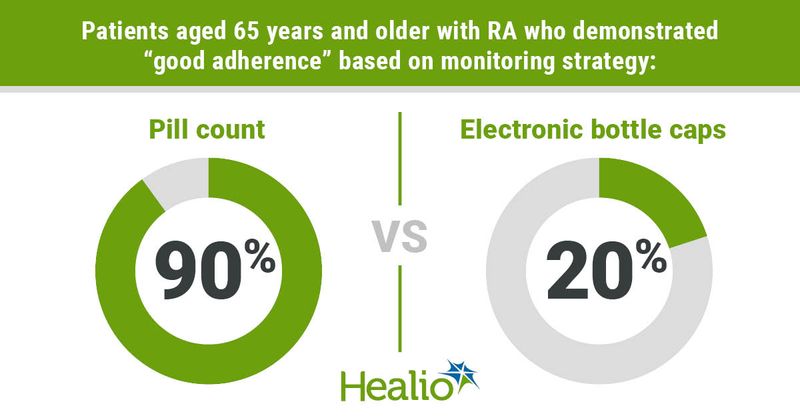Electronic monitoring fails to adequately gauge drug adherence in older patients with RA
Electronic monitoring, using caps that record when a pill bottle is opened, contradicts pill counts in measuring drug adherence among patients aged 65 years and older with rheumatoid arthritis, according to data published in Rheumatology.
Overall, drug adherence as measured by the electronic caps was 48%, compared with 97% based on counts of returned capsules. According to the researchers, this discrepancy is due to patients failing to open or close the bottle each day as directed.

“Suboptimal medication adherence is a serious problem in the treatment of chronic inflammatory diseases,” Linda Hartman, MSc, of Amsterdam UMC and Vrije University, in the Netherlands, and colleagues wrote. “Medication adherence, generally defined as the extent to which a person’s behavior (taking medication in our case) corresponds with agreed recommendations from a health care provider, is often below 50% in patients with chronic diseases such as rheumatoid arthritis.
“Methods to measure medication adherence include questionnaires, pill counts, electronic monitoring and monitoring drug levels in blood or urine,” they added. “However, there is no consensus about the best method. Electronic monitoring consists of a cap with an internal electronic device that records the date and time of each opening and closing of the bottle. Such monitoring may be superior to pill count which often overestimates the medication adherence.”
To compared electronic monitoring through digital caps to pill counts in measuring drug adherence in older patients with RA, Hartman and colleagues conducted an adherence study as part of the Glucocorticoid Low-dose Outcome in RheumatoId Arthritis (GLORIA) trial. This 2-year, randomized double-blind, pragmatic multicenter study examined the addition of low-dose prednisone or placebo to standard car in patients aged 65 years or older with RA. By the end of enrollment in 2018, the study had recruited 451 participants from 28 centers in Germany, Hungary, Italy, the Netherlands, Portugal, Romania and Slovakia.
For the adherence part of the study, Hartman and colleagues included all participants, regardless of factors such as the use of pill boxes or the need for assistance with taking medication. Participants received one or two medication bottles with electronic caps at every clinic visit, for a total of at least eight bottles in a period of 2 years. Each bottle included 90 pills. Instructions were given to participants to open the bottle every day and to take only the pill for that day out of the bottle. Participants were aware that adherence would be monitored through electronic caps and the counting of returned pills.
GLORIA’s follow-up period is ongoing. The current dataset presented by Hartman and colleagues for adherence included 371 participants for the electronic caps and 416 for pill counts. The number of participants for electronic monitoring and pill count data is different due to not all caps being returned at the time of reporting.
According to the researchers, 90% of the patients had “good adherence” based on counting returned pills. Meanwhile, just 20% demonstrated “good adherence” based on electronic monitoring only. In addition, electronic cap data classified 30% of participants as non-users — defined as those who opened their bottle on fewer than 20% of days — and 40% as irregular users.
“This study suggests that electronic monitoring as implemented in our trial is less suitable than pill count to measure medication adherence in older people with RA,” Hartman and colleagues wrote. “Most patients did not implement the dosing regimen, ie they did not open (or close) the bottle daily as prescribed, but irregularly or rarely instead. Interviews suggested this was at least in part due to difficulties with opening the bottle or use of other pill boxes that were intermittently filled from the study medication bottle. For such patients, pill count is more suitable, or monitoring of blood levels where feasible.”
